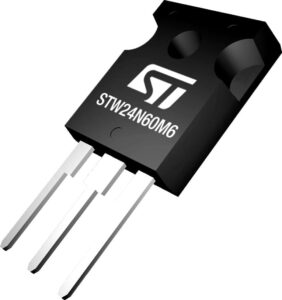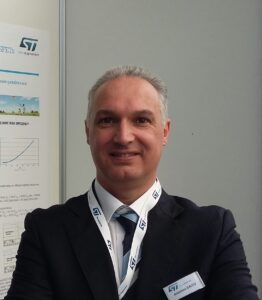
On November 28, 2019, ST will hold a webinar on the STPOWER MDmesh™ M6 and DM6. Alfio Scuto, Application Manager High Voltage MOSFET, and Antonino Gaito, Marketing Manager High Voltage MOSFET will lead the presentation. MDmesh M6 and MDmesh DM6 were at the center of papers1, 2 presented by ST last May 2019 at PCIM Europe 2019 and which showcased their performance compared to the rest of the industry. MDmesh M6 has a breakdown voltage of 600 V to 700 V, while MDmesh DM6 has a VDSS between 600 V and 650 V and offers automotive-grade models. Both have an output capacitance (Coss) that significantly improves the power efficiency at light load, but the latter also provides a faster diode reverse recovery time (Trr) to boost performance in more demanding conditions further.
We recently celebrated the 20th anniversary of the MDmesh family of superjunction MOSFETs, which uses a P+ column or trench into the N- epitaxial layer to dope the drift region and lower the on-resistance RDS(on). It explains why they are highly prevalent in high-voltage applications. MDmesh M6 and DM6 are one of our latest series and they target ZVS (Zero Voltage Switching) soft switching topologies, such as phase-shifted full bridge as well as LLC half and full bridge. MDmesh M6 addresses servers and some switched-mode power supply for consumer devices, whereas MDmesh DM6 tailors to electric cars, SMPSs for telecom equipment, 5G equipment, or solar inverters. It can be a challenge for engineers to find the best device for their design and sift through the sea of datasheets to spot the most pertinent values. The webinar is here to assist them.
MDmesh M6 and Coss: The Importance of the Output Capacitance on the Efficiency

The MDmesh M6 and DM6 presentation will be broad and cover a wide range of topics, but as we sat down with Alfio, he explained that the output capacitance (Coss) deserves more attention than it usually gets. Different studies already show that to truly understand the energy losses of a MOSFET working in resonant applications, it is necessary to know how the output capacitance transfers energy at all loads. One measure at a particular load is not enough. In a classical ZVS topology, the bridge’s MOSFETs send current to the resonant tank. The output capacitance thus determines the efficiency of this energy transfer. Unfortunately, teams can sometimes overlook this characteristic and focus solely on things like the channel on-resistance or the body diode.
The webinar will show a benchmark that tracks temperatures during the energy swaps between the Coss of the MOSFETs and the inductor. The test platform doesn’t use a heat sink and proves that an inadequate device quickly can heat up because of its power losses, meaning that an improper Coss can have grave consequences. We also show that Coss is essential because it is one of the primary sources of power losses at light load. When pushing the output of the power supply to its upper limits, the on-resistance, the losses of the body diode, and many other factors affect the overall performance, and the output capacitance fades in the background, which is why designers don’t always think of it. At low load, Coss is one of the significant factors generating losses. The excellent output capacitance of the MDmesh M6 and DM6, therefore, explain their excellent average power efficiency.
MDmesh DM6 and Trr: The Impact of the Reverse Recovery Time on Ruggedness

The body diode reverse recovery time improves the reliability of the system. Put simply, it tracks, in nanoseconds, the time it takes the diode to go from conduction to a non-conduction state. It is an essential value because when the load changes quickly, the recovery time must be short enough to respond to the sudden changes, or it could damage the system. When the current in the forward direction is high, the reverse recovery time takes longer to remove the carriers and block the reverse voltage. However, when the applied voltage is higher, the recovery time is shorter. It’s thus essential to check the applied voltage when looking at the Trr value in a data sheet. Whereas many devices competing against MDmesh M6 and DM6 describe their Trr at 400 V, ST measures it at 60 V to offer a better estimate of real-life performances.
During the webinar, Alfio will introduce benchmarks that compare MDmesh M6 and MDmesh DM6 to show how the latter can tolerate much greater changes in current and voltage over the same period, to help engineers understand how to choose a component. Why choose MDmesh DM6 and its very short Trr? Chargers for electric cars, solar inverters, or SMPS for telecom applications must work at high overall power efficiency independently from the load consumption. As a result, they require a much more robust device that can tolerate greater variations. Additionally, by significantly improving efficiency, they help reduce carbon emissions. As companies always need more data farms, cloud servers, or clean vehicles, the improvements in efficiency afforded by the MDmesh DM6 are ever more impactful.
The Advantages of the TO-LL Package
Alfio will finally describe the numerous packages available and stop to talk about the TO-Leadless (TO-LL) housing, which can improve efficiency and reduce the thickness to enable the creation of compact SMPS solutions. Put simply; it offers a Kelvin pin near the source to serve as the absolute ground at the die level, which enables faster on-off switching operations. A benchmark comparing an 80 mΩ MDmesh M6 TO-LL device against an identical model using a TO-220 package shows that in an 800 W PFC stage, both have a similar efficiency until 400 W (middle load). After that, the increase in switching currents means that the kelvin pin enables a much better overall efficiency. Moreover, TO-LL is also 30% smaller than a D2PACK component and is only 2.3 mm thick. Currently, only MDmesh M6 is available in a TO-LL package.
Suggested Reading Before the Webinar:
- Application Note 2644: An introduction to LLC resonant half-bridge converter
- Application Note 4720: Half bridge resonant LLC converters and primary side MOSFET selection
Register to the webinar: Discover STPOWER MDmesh M6 and DM6 MOSFET technologies
- F. Scrimizzi, A. Scuto, S. Buonomo and D. Nardo, “ST’s MDmesh™ M6 technology improves efficiency in LLC resonant half-bridge converters,” PCIM Europe 2019; International Exhibition and Conference for Power Electronics, Intelligent Motion, Renewable Energy and Energy Management, Nuremberg, Germany, 2019, pp. 1-7.http://ieeexplore.ieee.org/stamp/stamp.jsp?tp=&arnumber=8767587&isnumber=8767471 ↩
- C. Parisi, M. Melito, F. Fusillo and D. Nardo, “MDmesh™ DM6: The latest Super-junction MOSFET technology with improved fast recovery diode,” PCIM Europe 2019; International Exhibition and Conference for Power Electronics, Intelligent Motion, Renewable Energy and Energy Management, Nuremberg, Germany, 2019, pp. 1-7.http://ieeexplore.ieee.org/stamp/stamp.jsp?tp=&arnumber=8767588&isnumber=8767471 ↩
